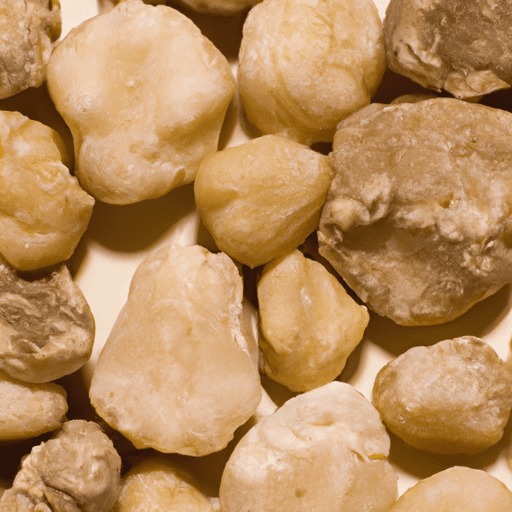Candlenut: A Versatile and Nutrient-Packed Ingredient
Candlenut, also known as “buah keras” or “kemiri” in Southeast Asia, is a unique and versatile ingredient with a rich culinary history. Though small, this nut packs a powerful punch of flavor and adds an unmistakable nutty aroma to various dishes. In this blog post, we will explore the taste, common uses, nutritional value, and interesting facts about candlenut.
Taste and Aroma Candlenut boasts a distinct taste that can be described as rich, creamy, and slightly bitter. When roasted or sautéed, it develops a pleasant nutty flavor that enhances the overall complexity of dishes. Its aroma is robust and can be compared to a blend of almonds and macadamia nuts.
Common Uses in Cooking Candlenut is a staple ingredient in Southeast Asian cuisines, particularly Indonesian, Malaysian, and Singaporean dishes. It is widely used as a thickening agent and can be ground into a fine paste or pureed to create a thickening base for curries, stews, and sauces. In Indonesian cuisine, it is a key element in rendang, a famous slow-cooked meat dish.
Candlenut is also frequently added to spice blends or sambal, a chili-based condiment. Its unique flavor complements well with various proteins such as poultry, fish, and beef, and it adds a delightful crunch when sprinkled over salads or stir-fries.
Nutritional Value In addition to its culinary prowess, candlenut offers several nutritional benefits. This small nut is an excellent source of healthy fats, primarily monounsaturated fats, which contribute to heart health. It also contains a decent amount of protein, dietary fiber, and essential minerals like calcium, iron, and phosphorus.
It is worth noting that candlenuts are high in calories, so moderation is key when incorporating them into your diet. However, their high nutrient content makes them a valuable addition to a well-balanced eating plan.
Interesting History and Facts Candlenut holds a significant place in Southeast Asian culture and history. In ancient times, the oil extracted from candlenuts was widely used as fuel for traditional lamps, hence the name “candlenut.” This oil was also employed in cosmetic preparations, known for its moisturizing and nourishing properties.
Outside of culinary uses, candlenut has traditional medicinal applications. It has been used for generations as a remedy for various ailments, including skin irritations, sore throats, and inflammation. However, it is essential to consult a healthcare professional before using candlenut for its medicinal properties.
In Conclusion Candlenut is a unique and flavorful ingredient that adds depth and complexity to various dishes. Its creamy, nutty taste, along with its versatility in different culinary preparations, makes it a beloved element in Southeast Asian cuisines. Moreover, candlenut’s nutritional value and interesting history further enhance its appeal.
So, next time you want to elevate your cooking to new heights, be sure to explore the wonderful world of candlenut and discover the irresistible flavors it brings to your table.
Candlenut
Candlenut, scientifically known as Aleurites moluccana, is a large nut that is native to Southeast Asia and the Pacific Islands. It is known by different names in various regions, such as “kemiri” in Indonesia, “kukui nut” in Hawaii, and “buah keras” in Malaysia and Singapore.
Cultivation of candlenut is believed to have originated in the Moluccas (also known as the Spice Islands), which are part of modern-day Indonesia. It has since spread to other tropical regions around the world.
Candlenuts are widely used in culinary traditions across Southeast Asia, particularly in Indonesian, Malaysian, and Filipino cuisines. They are an essential ingredient in dishes like rendang, a flavorful Indonesian curry, and kari ayam, a Malaysian chicken curry.
One of the most distinctive features of candlenuts is their high oil content. They have the highest oil content of any nut, with approximately 70-80% fat. This characteristic has led to their traditional use as candles, hence the name “candlenut.”
In addition to their culinary uses, candlenuts have historically been used in traditional medicine. They are believed to have various therapeutic properties and are used to treat ailments such as headaches, skin irritations, and constipation.
Nutritionally, candlenuts are rich in monounsaturated fats, which are considered heart-healthy fats. They also contain significant amounts of protein, dietary fiber, and various minerals like calcium, iron, and potassium.
It is important to note that raw candlenuts are mildly toxic and can cause gastrointestinal discomfort if consumed in large quantities. Therefore, they are typically roasted or cooked before being used in recipes to neutralize the toxins.
The candlenut tree itself is valued not only for its nuts but also for its durable wood. The wood is used in various applications, including construction, furniture making, and even for the production of traditional musical instruments.
Traditionally, candlenuts were strung together and used as leis or necklaces in Hawaii. In addition, the oil extracted from candlenuts has been used for cosmetic purposes, such as moisturizing and protecting the skin and hair.
Due to their distinct flavor and rich texture, candlenuts are highly coveted in culinary circles. They provide a unique nutty and creamy taste, enhancing the overall flavor and texture of dishes they are incorporated into.




Use the share button below if you liked it.
It makes me smile, when I see it.